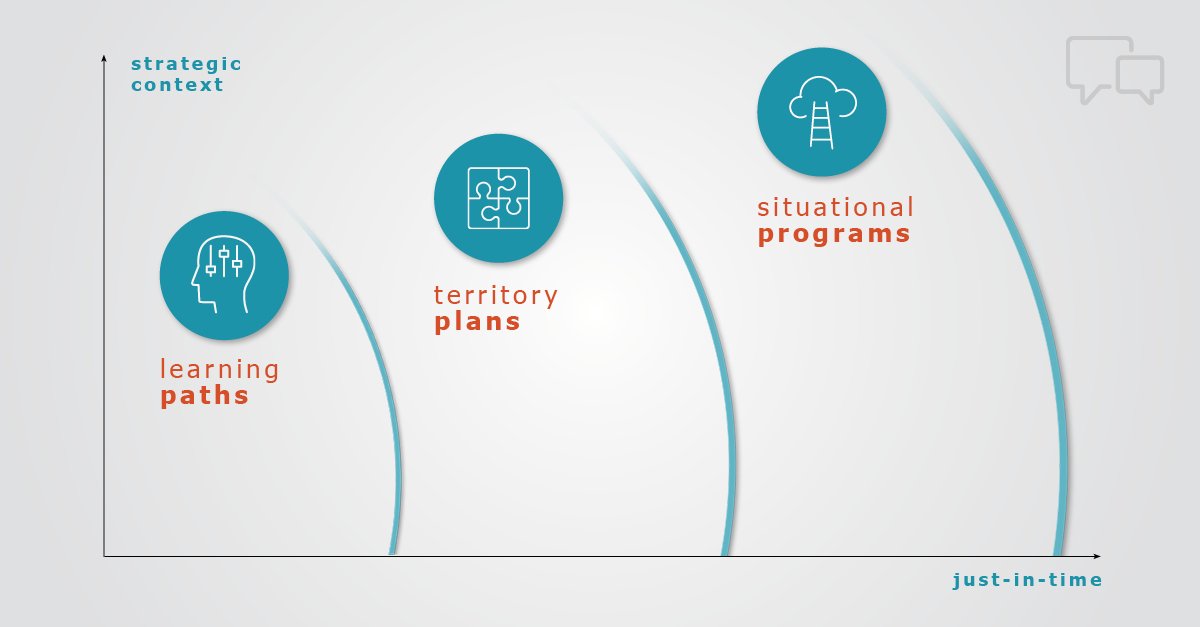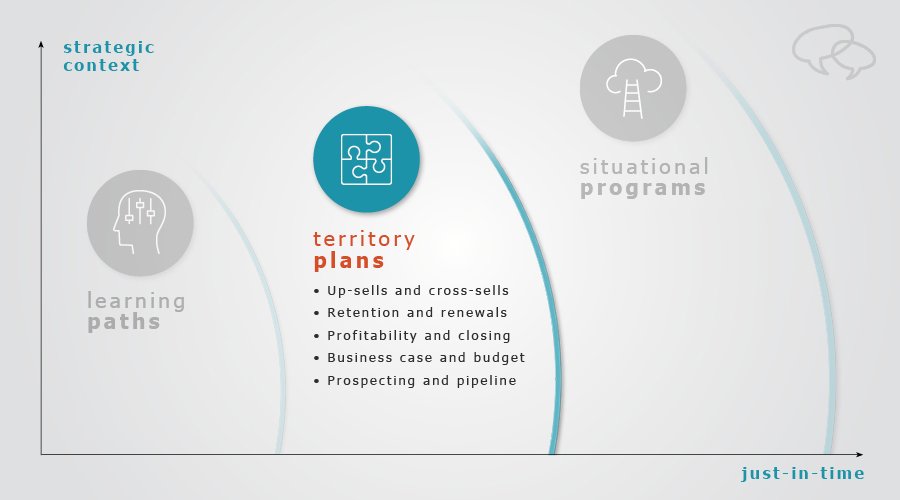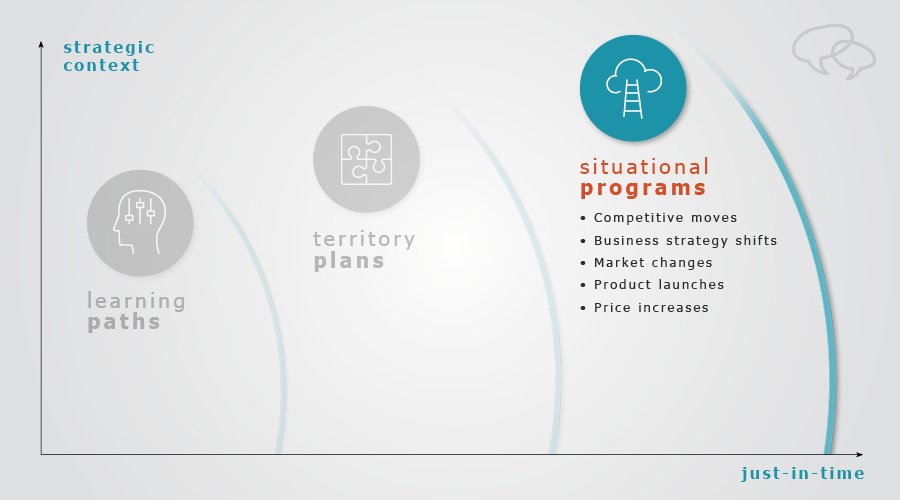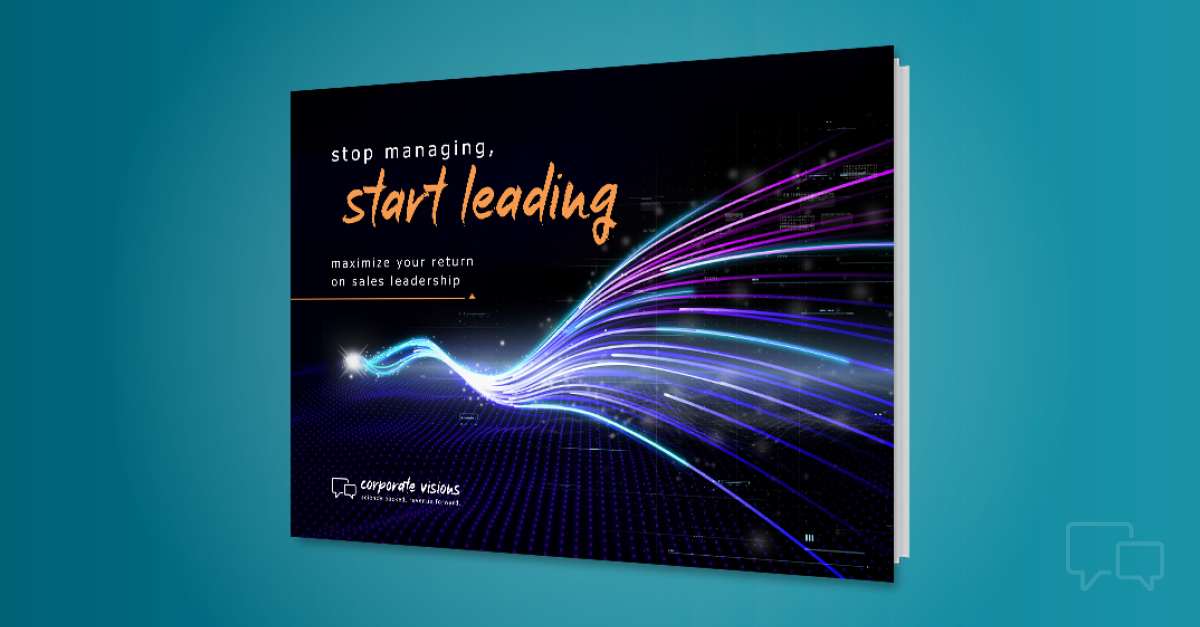
In Alvin Toffler’s book, “The Third Wave,” he talks about society’s transition from the Industrial Age (Second Wave) to the Information Age (Third Wave). Toffler considered the Agricultural Age as the First Wave transition from our hunter-gatherer origins.
You can think of training and enablement programs as similar waves along a continuum.
As you move from left to right across the x-axis, your enablement programs become more flexible and more situational. As you move up the y-axis, those programs gain more executive altitude, becoming more strategic and immediately impactful to the company’s growth agenda.
To move up and to the right in this model, your enablement organization must become faster, more flexible, and more responsive, equipping the field to address more acute, must-win business challenges and market opportunities.
The First Wave: Learning Paths

The first wave in training and enablement is represented by traditional Learning Paths, the original development programs. Like society’s big, first wave—the Agricultural Age—Learning Paths were once a breakthrough.
Programs such as onboarding, competency map-based training, role change, and tenure-based options, as well as the occasional global rollout of a new process or technology, could separate one organization from another.
Learning Paths such as these follow a planned, cataloged, and calendared process, teaching people what they will need to know (at some point) in their daily jobs and careers. These programs could take months or even years to roll out across your entire organization.
Still, for companies that executed Learning Paths better than other companies, it became a differentiator in terms of market performance. And, it made those companies a magnet for top talent.
Over time, Learning Paths have become the standard at most companies. They remain foundational to any good learning and enablement program. But, just as the first wave of agricultural society gave way to the second wave of industrial society, so too Learning Paths transitioned to more situational, Territory Plan-based learning and enablement.
The Second Wave: Territory Plans

The second wave of sales enablement, moving up and to the right, is what we call the Territory Planning wave. Programs in this wave are based on the sales managers’ decisions about what their teams and territories need to make quota. It also includes an examination of key performance indicators for individual reps to determine training needs, especially now that CRM data is more prevalent.
For example, a manager may look across their team and territory for the upcoming year and see that their revenue number is highly dependent on acquiring new customers. Whereas, another manager may see their territory and quota as relying most heavily on expanding existing customers.
Key performance indicators can also tell you which reps are struggling in critical areas such as:
- Prospecting and Pipeline Creation – Identify reps with “starving funnels” who need programs to help them convince prospects to change and choose you.
- Proposal and Deal Closing – Find the reps with “constipated pipelines.” These reps have lots of proposals, but too many stalled, no-decision deals. And they need support building better executive-level business cases.
- Negotiations and Discounting – Review deal profitability to find the “unscrupulous discounters.” These reps can close the business but give too much away, and they need help protecting your pricing and margins.
- Renewals and Price Increases – Determine where your big subscriptions or contracts are coming due helps you find the “business defenders,” whose year depends on avoiding churn and retaining key clients.
- Upsells and Cross-Sells – Analyze existing customers to identify white space opportunities for upgrades and add-on sales. Then you can identify the “land and expanders” you need to help grow existing accounts.
Once you know what each manager needs for their territory, and you identify the cohorts of sellers who are lagging in each of these areas, you can provide programs more closely aligned to the revenue and growth targets of the company.
Imagine executing a plan for the year that you can show directly addresses the most significant needs of each manager and rep relative to hitting their quota?
Before you assume an approach like this isn’t scalable, look again.
Territory-based plans essentially require you to have a training and enablement curriculum available for the five main KPIs mentioned above. Getting your messaging, content, skills, and coaching synched to each of those five areas gives you the flexibility to assess what individuals need, and then put them in those respective programs. It’s a manageable approach to bespoke training.
The other benefit is that each of these five areas connects to something measurable where most companies already have access to data. You can use the data to determine who needs what and then monitor that same data to see if the programs improved the desired KPI for that specific territory and/or rep.
In this way, your training and enablement programs can be better tied to outcomes and overall company performance. That’s why we refer to it as the Second Wave of training and enablement. You’re moving up and to the right, toward more situational relevance and higher executive altitude.
The Third Wave: Situational Programs

The third wave in society was the move from incredible breakthroughs of the Industrial Age to the mind-blowing possibilities of the Information Age. Similarly, training and sales enablement is now poised for a third wave that we call Situational Programs.
These initiatives are tied to the most urgent and strategic needs of the company. High-stakes situations that show up within a quarter and must be addressed immediately. In these situations, you can’t wait multiple quarters to stand up and roll out a program to respond—by then it will be too late.
Examples of situational needs include:
- Price increases vital to growth, but must be handled well to avoid churn
- Product launches with short windows of opportunity to leverage a competitive advantage
- Market changes where customers are looking for essential insight and advice
- Business strategy shifts that must be communicated well for maximum positive impact
- Competitive moves that require a fast, meaningful response to protect your installed base
As you can see, these events are furthest up and to the right on the chart because they happen fast and have significant consequences. They are often driven from the most senior executive levels of the company, with all eyes watching the response and the outcome.
Sales enablement at this level requires aligning the entire organization on the right story and the right skills to tell that story in weeks, not months. This demands flexible and responsive content, deployment options, and “fit for duty” demonstrations of proficiency.

In this blog series, I’m giving you more details on what it looks like to execute Situational Sales Enablement at your company.
Watch our on-demand webinar, The Power of Situational Enablement, to learn more about this new model for training and enabling your team.
Read the other articles in the series:
Next up: Examples of Situational Enablement





